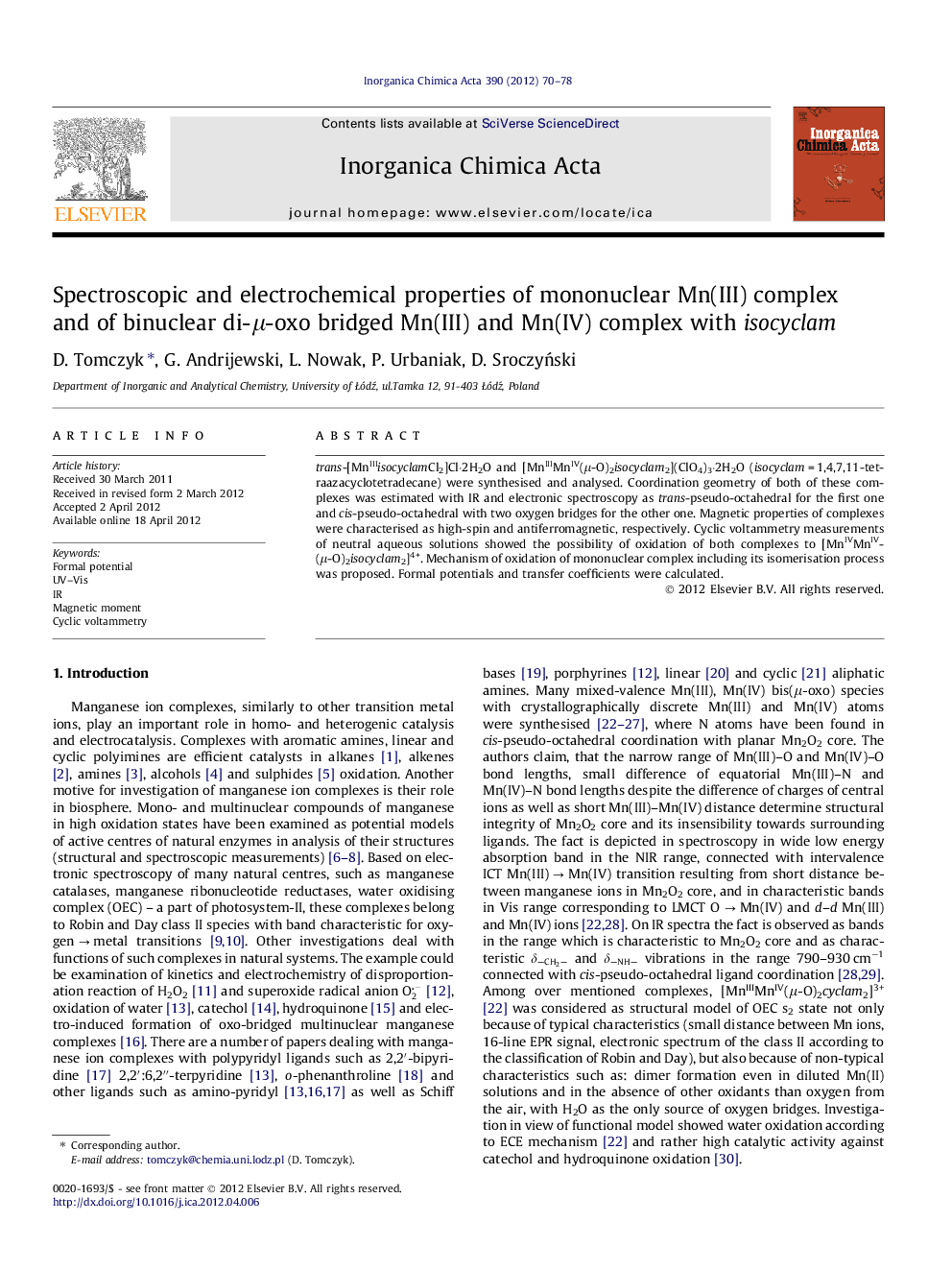| Article ID | Journal | Published Year | Pages | File Type |
|---|---|---|---|---|
| 1312435 | Inorganica Chimica Acta | 2012 | 9 Pages |
trans-[MnIIIisocyclamCl2]Cl·2H2O and [MnIIIMnIV(μ-O)2isocyclam2](ClO4)3·2H2O (isocyclam = 1,4,7,11-tetraazacyclotetradecane) were synthesised and analysed. Coordination geometry of both of these complexes was estimated with IR and electronic spectroscopy as trans-pseudo-octahedral for the first one and cis-pseudo-octahedral with two oxygen bridges for the other one. Magnetic properties of complexes were characterised as high-spin and antiferromagnetic, respectively. Cyclic voltammetry measurements of neutral aqueous solutions showed the possibility of oxidation of both complexes to [MnIVMnIV(μ-O)2isocyclam2]4+. Mechanism of oxidation of mononuclear complex including its isomerisation process was proposed. Formal potentials and transfer coefficients were calculated.
Graphical abstractSyntheses of mononuclear Mn(III) complex and binuclear mixed-valence Mn(III)–Mn(IV) di-μ-oxo complex were described. Complex structures were estimated based on electron and infrared spectroscopy. Magnetic measurements showed high-spin character of mononuclear complex and antiferromagnetism of the binuclear one. Cyclic voltammetry of neutral aqueous solutions of binuclear complex and estimated transfer coefficient (1 − α) showed complex mechanism of the dimer [MnIIIMnIV(μ-O)2isocyclam2]3+ oxidation to [MnIVMnIV(μ-O)2isocyclam2]4+, in acidic media these measurements showed hydrolysis of oxygen bridges and process characteristic for mononuclear complex. Formal potentials were estimated. Exhaustive electrolysis of aqueous solution of [MnIIIMnIV(μ-O)2isocyclam2]3+ at its reduction and oxidation potentials, and electronic spectra of these solutions showed the possibility of both reduction and oxidation of dimer of Mn(III) and Mn(IV) ions to [MnIIIMnIII(μ-O)2isocyclam2]2+ and [MnIVMnIV(μ-O)2isocyclam2]4+, respectively. Voltammetric measurements of neutral aqueous trans-[MnIIIisocyclam(H2O)2]3+ solution after longer scanning showed oxidation of this complex analogically to the binuclear one, which was verified by controlled potential electrolysis (yield 32%) and electron spectroscopy. Mononuclear complex trans-[MnIIIisocyclam(H2O)2]3+ in acidic media undergoes one-electron reduction to ions of the same symmetry.Figure optionsDownload full-size imageDownload as PowerPoint slideHighlights► Syntheses of mono- and binuclear isocyclam manganese complexes were described. ► We confirmed the presence of mixed-valence Mn2O2 core by UV–Vis and IR spectroscopy. ► The electrochemical properties of these complexes were studied in aqueous solutions. ► We oxidised the mononuclear complex to the binuclear one (yield 32%). ► Mixed-valence complex may be reduced and oxidised to dimeric products.
